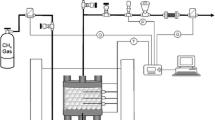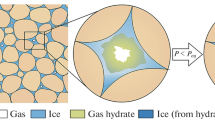Abstract
To better understand the relationship between the pore capillary pressure and hydrate saturation in sediments, a new method was proposed. First, the phase equilibria of methane hydrate in fine-grained silica sands were measured. As to the equilibrium data, the pore capillary pressure and saturation of methane hydrate were calculated. The results showed that the phase equilibria of methane hydrates in fine-grained silica sands changed due to the depressed activity of pore water caused by the surface group and negatively charged characteristic of silica particles as well as the capillary pressure in small pores together. The capillary pressure increased with the increase of methane hydrate saturation due to the decrease of the available pore space. However, the capillary-saturation relationship could not yet be described quantitatively because of the stochastic habit of hydrate growth.
Similar content being viewed by others
References
Anderson R, Llamedo M, Tohidi B, et al. 2003. Characteristics of clathrate hydrate equilibria in mesopores and interpretation of experimental data. Journal of Physical Chemistry B, 107(15): 3500–3506
Anderson R, Tohidi B, Webber J B W. 2009. Gas hydrate growth and dissociation in narrow pore networks: capillary inhibition and hysteresis phenomena. Geological Society, London, Special Publications, 319(1): 145–159
Bear J. 1972. Dynamics of Fluids in Porous Media. New York: Courier Dover Publications
Cha S B, Ouar H, Wildeman T R, et al. 1988. A third surface effect on hydrate formation. Journal of Physical Chemistry, 92(23): 6492–6494
Chen Litao, Sun Changyu, Chen Guangjin, et al. 2009. Measurements of hydrate equilibrium conditions for CH4, CO2, and CH4 + C2H6 + C3H8 in various systems by Step-heating method. Chinese Journal of Chemical Engineering, 17(4): 635–641
Chen Qiang, Ye Yuguang, Meng Qingguo, et al. 2009. Simulation experiment of the relationship between CO2 hydrate saturation and resistance in porous media. Natural Gas Geoscience (in Chinese), 20(2): 249–253
Cheng Chuanxiao, Zhao Jiafei, Song Yongchen, et al. 2013. In-situ observation for formation and dissociation of carbon dioxide hydrate in porous media by magnetic resonance imaging. Science China: Earth Sciences, 56(4): 611–617
Clennell M B, Hovland M, Booth J S, et al. 1999. Formation of natural gas hydrates in marine sediments. Part 1: Conceptual model of gas hydrate growth conditioned by host sediment properties. Journal of Geophysical Research B, 104(B10): 22985–23003
Dickens G R. 2004. Global change: Hydrocarbon-driven warming. Nature, 429(6991): 513–515
Gallo P, Rapinesi M, Rovere M. 2002. Confined water in the low hydration regime. Journal of Chemical Physics, 117(1): 369–3751
Ghezzehei T A, Kneafsey T J. 2010. Measurements of the capillary pressure-saturation relationship of methane hydrate bearing sediments. In: Proceeding of 2010 Offshore Technology Conference, held in Houston, Texas, USA. New York: Curran Associates, Inc., 933–946
Ginsburg G, Soloviev V, Matveeva T, et al. 2000. Sediment grain-size control on gas hydrate presence, Sites 994, 995, and 997. In: Paull C K, Matsumoto R, Wallace P J, et al., eds. Proceedings of the Ocean Drilling Program, Scientific Results, 164: College Station, TX (Ocean Drilling Program), 237–245
Handa Y P, Stupin D. 1992. Thermodynamic properties and dissociation characteristics of methane and propane hydrates in 70-aradius silica gel porest. Journal of Physical Chemistry, 96(21): 8599–8603
Hills B P, Manning C E, Ridge Y, et al. 1996. NMR water relaxation, water activity and bacterial survival in porous media. Journal of the Science of Food and Agriculture, 71(2): 185–194
Huang Lei, Fang Hongwei, Chen Minghong. 2012. Experiment on surface charge distribution of fine sediment. Science China Technological Sciences, 55(4): 1146–1152
Kashchiev D, Firoozabadi A. 2002. Nucleation of gas hydrates. Journal of Crystal Growth, 243(3–4): 476–489
Kerkar P, Jones K W, Kleinberg R W, et al. 2009. Direct observations of three dimensional growth of hydrates hosted in porous media. Applied Physics Letters, 95(2): 024102–024102-3
Lee S, Seo Y. 2010. Experimental measurement and thermodynamic modeling of the mixed CH4+C3H8 clathrate hydrate equilibria in silica gel pores: effects of pore size and salinity. Langmuir, 26(12): 9742–9748
Liu Changling, Ye Yuguang, Meng Qingguo, et al. 2010. Raman spectroscopic characteristics of natural gas hydrate recovered from shenhu area in south china sea and qilian mountain permafrost. Acta Chimica Sinica (in Chinese), 68(18): 1881–1886
Lu Hailong, Kawasaki T, Ukita T, et al. 2011. Particle size effect on the saturation of methane hydrate in sediments-Constrained from experimental results. Marine and Petroleum Geology, 28(10): 1801–1805
Lu Hailong, Matsumoto R. 2002. Preliminary experimental results of the stable p-T conditions of methane hydrate in a nannofossilrich claystone column. Geochemical Journal, 36(1): 21–30
Matsumoto R, Watanabe Y, Satoh M, et al. 1996. Distribution and occurrence of marine gas hydrates-Preliminary results of ODP Leg 164: Blake Ridge Drilling. The Journal of the Geological Society of Japan, 102(11): 932–944
Mitchell J K. 1993. Fundamentals of Soil Behavior. 2nd ed. New York: John Wiley
Mork M, Schei G, Larsen R. 2000. NMR imaging study of hydrates in sediments. Annals New York Academy of Sciences, 912: 897–905
Riedel M, Collett T S, Hyndman R D. 2005. Gas hydrate concentration estimates from chlorinity, electrical resistivity and seismic velocity. Geological Survey of Canada, 4934: 28–32
Riestenberg D, West O, Lee S, et al. 2003. Sediment surface effects on methane hydrate formation and dissociation. Marine Geology, 198(1–2): 181–190
Seol Y, Kneafsey T J. 2008. Fluid flow through heterogeneous methane hydrate bearing sand: observations using x-ray CT scanning. In: Proceedings of the 6th International Conference on Gas Hydrates (ICGH 2008). Vancouver, British Columbia, Canada: the 6th ICGH Organizing Committee
Sloan E D, Koh C A. 2008. Clathrate Hydrates of Natural Gases. 3rd ed. New York: CRC Press
Sultan N, Cochonat P, Foucher J P, et al. 2004. Effect of gas hydrates melting on seafloor slope instability. Marine Geology, 213(1–4): 379–401
Sun Shicai, Liu Changling, Ye Yuguang. 2013. Phase equilibrium condition of marine carbon dioxide hydrate. The Journal of Chemical Thermodynamics, 57: 256–260
Sun Shicai, Ye Yuguang, Liu Changling, et al. 2010. Preliminary experiment of P-T stable conditions of methane hydrate in quartz sand with multi-step dissociation method. Geoscience (in Chinese), 24(3): 638–642
Sun Shicai, Ye Yuguang, Liu Changling, et al. 2011a. Research of methane hydrate formation process in quartz sand. Chemical Engineering of Oil & Gas (in Chinese), 40(2): 123–127
Sun Shicai, Ye Yeguang, Liu Changling, et al. 2011b. Stable conditions for methane hydrate in quartz sand. Acta Chimica Sinica (in Chinese), 69(9): 1135–1140
Thompson H, Soper A, Ricci M A, et al. 2007. The three dimensional structure of water confined in nanoporous vycor glass. The Journal of Physical Chemistry B, 111(20): 5610–5620
Tohidi B, Anderson R, Clennell M B, et al. 2001. Visual observation of gas-hydrate formation and dissociation in synthetic porous media by means of glass micromodels. Geology, 29(9): 867–870
Turner D J, Cherry R S, Sloan E D. 2005. Sensitivity of methane hydrate phase equilibria to sediment pore size. Fluid Phase Equilibria, 228–229: 505–510
Uchida T, Lu Hailong, Tomaru H, et al. 2004. Subsurface occurrence of natural gas hydrate in the Nankai trough area: implication for gas hydrate concentration. Resource Geology, 54(1): 35–44
Uchida T, Tsuji T. 2004. Petrophysical properties of natural gas hydrates-bearing sands and their sedimentology in Nankai trough. Resource Geology, 54(1): 79–88
Wang Wannian. 1981. Flotation Theory-Wetting and Flocculation (in Chinese). Changsha: Hunan Science and Technology Press
Yang Mingjun, Song Yongchen, Liu Yu, et al. 2010. Influence of pore size, salinity and gas composition upon the hydrate formation conditions. Chinese Journal of Chemical Engineering, 18(2): 292–296
Ye Yuguang, Zhang Jian, Hu Gaowei, et al. 2008. Experimental research on relationship between gas hydrate saturation and acoustic parameters. Chinese Journal of Geophysics (in Chinese), 51(4): 1156–1164
Zhang Haiqi, Yang Shengxiong, Wu Nengyou, et al. 2007. Successful and surprising results from China’s first gas hydrate drilling expedition. Fire in the Ice: Methane Hydrate Newsletter, Fall Issue: 6–9
Zillmer M A. 2006. Method for determining gas-hydrate or free-gas saturation of porous media from seismic measurements. Geophysics, 71(3): N21–N32
Author information
Authors and Affiliations
Corresponding author
Additional information
Foundation item: The Open Fund of State Key Laboratory of Oil and Gas Reservoir Geology and Exploitation, Southwest Petroleum University under contract No. PLN1206; the National Natural Science Foundation of China under contract No. 51376114; the Ministry of Land and Resources research of China in the Public Interest under contract No. 201111026; the Open Fund of Shandong Provincial Key Laboratory of Depositional Mineralization & Sedimentary Minerals, Shandong University of Science & Technology under contract No. DMSM201007; the National Basic Research Program (973 program) of China under contract No. 2009CB219503.
Rights and permissions
About this article
Cite this article
Sun, S., Liu, C., Ye, Y. et al. Pore capillary pressure and saturation of methane hydrate bearing sediments. Acta Oceanol. Sin. 33, 30–36 (2014). https://doi.org/10.1007/s13131-014-0538-y
Received:
Accepted:
Published:
Issue Date:
DOI: https://doi.org/10.1007/s13131-014-0538-y




